
Exclusive reports from Crime Fiction's international big-bash by our roving reporter.
The closing ceremony of La Semana Negra, was held July 20 at 12pm in the biggest tent. It was rainy, and although Poniente’s beach was muddy, a lot of Gijoneses were present to make this as special as previous days.
Paco Taibo, II started the ceremony with a speech commenting on all the struggles that the organization of La Semana Negra has to go through every year to bring this event to the city. He thanked the city of Gijón for its unconditional support and acknowledged that although every year there are complaints about the noise, people, trash, and more, the number of people that attend proves to the city and to the few complainers that La Semana Negra is all about bringing literature and people together, about having a good time with family and friends. This year around a million people attended, and 51,000 books were sold. This shows the popularity of the event, and how even though our societies are changing, books and literature are still an important part of our lives. After the mayor, Taibo II, and city officials finished their speeches, the traditional “Rufo” prizes (La Semana Negra’s mascot--a black, chubby, figurine) was given to the persons who play a big role in the organization, security, planning, etc. in making La Semana Negra a successful ten-day event.
Since this is my last post on La Semana Negra I would like to highlight what I believe were some of the most incredible moments in Gijón. This is not a ranking, only a biased list of what I believe made these ten days so unforgettable.
1. The beautiful Asturian city of Gijón and its great weather. Not too hot, not to cold. Although they were warm days, a swim in the ocean freshened people right up, and the rain only made the city more beautiful because it would only last a day and the next day the city was sunny with clean and shiny streets.
2. The Taibo family. They were always present at the events and offered you their help, smiles and good sense of humor. Paco Ignacio Taibo, II dedicates three months of the year to the planning of La Semana Negra, and anyone can definitely notice the love he puts into it. Twenty-one years don’t go unnoticed. His wife Paloma Saiz and daughter Marina also play a big role and deserve recognition: Thank you! 3. The invited writers. The list of writers is very long, but I would like to highlight Cuban writers, Amir Valle, Lorenzo Lunar and Rebeca. Not only excellent writers, but also wonderful people.
4. The Colombians, Mario Mendoza, and Nahum Montt, who called themselves “the grandkids of Gabriel García Márquez”, who “unlike his sons, don’t owe him anything.” Their thriller and detective fiction about Colombia, a clear and non-magical realistic picture of this South American country.
5. The interview and everyday conversations with Rolando Hinojosa, an intelligent man and as Daniel Olivas calls him, “one of the maestros.” His advice, not only journalistic but also academic, and most importantly all he had to say about the years he has attended La Semana Negra, made me work hard every day, take notes, record the literary sessions, and hope that one day I will become as smart as him. Truly an inspiration.
6. The every-day 5:00 tertulias at the main tent, where you could learn everything about the writers: from their writing techniques, their geeky side, to what they drink and eat when they write. And also deep conversations on evil vs. good, monsters in literature, etc. There are not a lot of places where this still happens, or if you know where it does, please let me know. 7. The book presentations, where you could hear a writer present their book, answer questions, sign books, and have conversations with readers afterward. A very intimate experience where people have the opportunity to take pictures with the writers and maybe even ask them out. I swear I didn’t try this.
8. “La velada poética”-Poetry night. An incredible night with world famous poetas José Emilio Pacheco, Joaquin Sabina and Luis García Montero. There is something about a room full of people eager and anxious to listen to their favorites poets. The hour or so that the poets recited was a surreal experience, definitely one of the main events of La Semana Negra. So if after reading so much about La Semana Negra on La Bloga you decide that it's surely worth making such a far away trip next year, believe me--the poetry night will be worth all your dollars spent. You can check out a really good video of this event on YouTube.
9. The night dedicated to Ángel González. The poetry night, held Friday the 18th will be marked in the history of La Semana Negra as the night Gijón remembered and paid loving tribute and respect to a great and dearly loved poet.
10. The Semana Negra book, food, and jewelry tents--the free spirit and relaxing attitude of the people and the event itself; the smell of churros accompanying you as you go around the tents trying to find that particular book you know you can only find in Spain; watching families spending time together; walking around the fair or sitting on the sand reading a book.
I would like to thank La Bloga, especially Daniel Olivas for all the support and RudyG for posting my reports (cropping pictures, editing, and much more), and to all the people that have been reading and commenting on them (Norma Landa Flores, always the first and sweetest). It has been a great experience being La Bloga’s “roving reporter” and attending La Semana Negra itself. Here is my email for questions, concerns, and whatever else comes to mind: thaniamunoz AT yahoo.com.
Saludos desde Los Angeles,
I love La Bloga!
Thania Muñoz
Viewing: Blog Posts Tagged with: Gijón, Most Recent at Top [Help]
Results 1 - 7 of 7
Blog: La Bloga (Login to Add to MyJacketFlap)
JacketFlap tags: 2008, Rolando Hinojosa, Semana Negra, Gijón, Thania Muñoz, José Emilio Pacheco, Luis García Montero, Mario Mendoza, Amir Valle, Nahum Montt, Joaquin Sabina, Lorenzo Lunar, Ángel González, Add a tag
Blog: La Bloga (Login to Add to MyJacketFlap)
JacketFlap tags: Semana Negra, Gijón, Thania Muñoz, Juan Ramón Biedma, Sanjuana Martínez, literary prizes, Javier Negrete, Carlos Salem, Nacho Padilla, Antonio Sarabia, Leonardo Oyola, 2008, Add a tag

Exclusive reports from Crime Fiction's international big-bash by our roving reporter.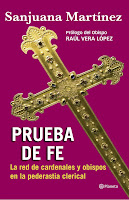 7th day - La Semana Negra recognition
7th day - La Semana Negra recognition
Every year La Semana Negra awards writers for their literary work. The jurors of the prizes are always fellow writers, and although the prize is not monetary, as Spanish writer and one of the winners of the Hammett award said, “It gives you prestige because it is not driven by anything else than the quality of the work. It's very transparent.”
Here is the list of categories and the 2007 winners: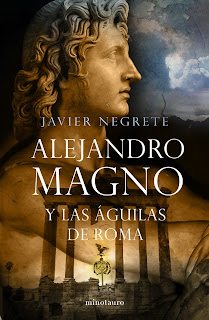 The Hammett Prize to the best detective fiction novel written in Spanish given by the Asociación de Escritores Policíacos:
The Hammett Prize to the best detective fiction novel written in Spanish given by the Asociación de Escritores Policíacos:
This award was a tie, so it’s shared between the Spanish Juan Ramón Biedma for his novel El Imán y la Brújula and the Argentinean Leonardo Oyola for Chamamé.
The Espartaco (Spartan) Prize given to the best historical novel written in Spanish was given to the Mexican writer Antonio Sarabia for his novel Troya al Atardecer.
The Memorial Silverio Cañada Prize given to the best first published detective fiction novel written in Spanish was given to the Argentinean writer Carlos Salem for his book Camino de Ida.
The Rodolfo Walsh Prize, for the best nonfiction detective book written in Spanish, was given to the Mexican writer Sanjuana Martínez for Prueba de Fe. The Celsius 232 Prize for the best science fiction or fantasy novel was given to the Spanish writer Javier Negrete for his book Alejandro Magno y las águilas de Roma. There was a special mention by the jury to the Spanish writer José Carlos Somoza for his book La Llave del Abismo.
Also, for a short story contest, the Ateneo Obrero de Gijón Prize was given to Nacho Padilla for “Viaje al centro de una chistera” (Trip to the center of a top-hat).
The prizes were given at 10:30am on July 19th at a press conference in Gijón’s Hotel Don Manuel. The room was jam-packed with nominated writers, press, and all the staff of La Semana Negra. There was a special energy in the room, and although local television channels were present covering the prizes, everything seemed so intimate. No one except the jurors, not even Paco Taibo, II, knew who the winners were, so everyone was anxious and expectant, especially the nominees.
The winner of each category was read off by one of the jurors. They opened a white envelope and off a handwritten letter read a special message from all the jurors and then announced the winner. Every time one was read, the room was invaded by a wave of claps, yells, and hugs for the winners.  Leonardo Oyola, a winner of the Hammett Prize shed a few tears. Carlos Salem was also very moved and happy; it’s his first published novel ("Camino de ida"), and as he said when he received the prize, “Your own fellow writers are the ones who recognize your work, and that makes this prize so important.”
Leonardo Oyola, a winner of the Hammett Prize shed a few tears. Carlos Salem was also very moved and happy; it’s his first published novel ("Camino de ida"), and as he said when he received the prize, “Your own fellow writers are the ones who recognize your work, and that makes this prize so important.”
All the writers recognize the importance of giving each other recognition, but in the case of Sanjuana Martínez and his investigation book on the victims of Mexican Catholic pederast priests, she affirmed that the award is also “recognition of the courage of the victims, to all those who have suffered and are still suffering.”
Following is a short introduction to the winner’s books. I hope these books get translated into English soon, but if not, definitely keep a close watch for them, because Semana Negra winners have a tendency to win more literary prizes.
The Hammett Prize: Juan Ramón Biedma's El Imán y la Brújula is a political novel of Spain during 1926, an espionage plot, where extreme situations are abundant and with the end of the war of Morocco as a background.
Leonardo Oyola's Chamamé (a traditional danceable rhythm of the northeastern Argentina) is about the persecution of two asphalt pirate gangs after the theft of loot. A vibrant story about a settling of scores.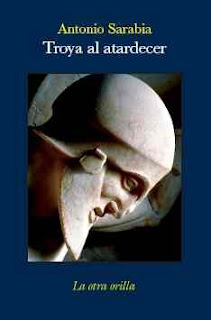 The Espartaco (Spartan) Prize: Antonio Sarabia's Troya al Atardecer is a war novel that tells the story of twin brothers who fight on opposing sides.
The Espartaco (Spartan) Prize: Antonio Sarabia's Troya al Atardecer is a war novel that tells the story of twin brothers who fight on opposing sides.
The Prize Memorial Silverio Cañada: In Carlos Salem's Camino de Ida, Octavio Rincón’s authoritarian woman dies during their vacation, and it’s the best thing that ever happened to him. Perplexed at the fact that his most profound wish in life has been realized and confused between this wish and his fear of becoming a suspect of her death, he embarks on a wild journey.
The Rodolfo Walsh Prize: Sanjuana Martínez's Prueba de Fe is a denunciation book against at least two prominent Catholic cardinals, Norberto Rivera Carrera and Juan Sandoval Iñiguez.The Celsius 232 Prize: Javier Negrete's Alejandro Magno y las águilas de Roma. Alejandro didn’t die in Babilonia. The hypothesis presented in the book is that he was poisoned by his ambitious wife Roxana in connivance with Perdicas, one of the generals, but a mysterious doctor Nestor arrives just in time to neutralize the intoxication.
José Carlos Somoza's La Llave del Abismo is a futuristic thriller that evokes a shadow universe. It is also a journey through the ins and outs of faith, a reflection over what it means to kill in the name of religious beliefs, and a revelation of what is hidden behind them.
Saludos desde Gijón!
Thania Muñoz
Blog: La Bloga (Login to Add to MyJacketFlap)
JacketFlap tags: poetry, poems, 2008, poets, Semana Negra, Paco Taibo, Gijón, Thania Muñoz, crime fiction, España, José Emilio Pacheco, Joaquín Sabina, Luis García Montero, Yampi, Add a tag

Exclusive reports from Crime Fiction's international big-bash by our roving reporter.
6th Day - Thursday's Poetry ReadingThis morning, José Emilio Pacheco, Joaquín Sabina and Luis García Montero read their poetry at the main tent of La Semana Negra. Since the recital was scheduled for one in the morning, I had planned to arrive an hour before, thinking I was going to get a good, comfortable spot. But it seemed dozens of people thought the same thing. Usually at this hour people are at the clubs dancing away the night, and you would think no one would even think about poetry. But in Gijón this was not the case.
As Paco Ignacio Taibo, II said, “Some years ago when I proposed a poetry reading late at night, people said I was crazy, that no one would actually attend.” But in fact a lot of people attended, and as I made my way through the audience that was trying to find chairs and move closer to the stage, I soon realized I wasn’t going to get a chair. So I made my way through to the front to sit wherever possible. I got a little spot right on the front between two couples and took out my camera. I’m a big poetry reader and just thinking that I was going to be listening to these three important poets of the Spanish language made me shiver. Before the recital, the tent was noisy, people desperately trying to find a place, but by 1:00am, no one else was able to get in. This made me feel more excited, and I felt envious looks from people behind me.The recital got started by Yampi who livened up the tent with his guitar so people started singing. With his endless smile, Yampi thanked everyone for being there so late at night. He honored the deceased poet Ángel González by singing some of his poems, verses that quickly changed the mood of the tent. Ángel González died this year on January 12th and his death is most felt at La Semana Negra, because since the late-night poetry readings got started by Paco Ignacio Taibo II, Ángel had never missed a year.
Joaquín Sabina, famous songwriter and poet, has been attending La Semana Negra for the last six years and Luis García Montero, has also attended for many years. The only newbie was José Emilio Pacheco, who in some way came to replace Ángel González. Not an easy task, but knowing that José Emilio is considered one of the most important Mexican poets of our time, with his brilliant work in narrative, translation and most importantly poetry, he had nothing to fear. A little after 1:00 Paco Taibo went on the stage and people went crazy clapping. Taibo said how happy he felt that so many people were at the event and that he knew we would truly enjoy it because, "poetry has less and less space in our society." He introduced the poets and surrounded by claps, cheers and yells, the three poets got on stage and waved to everyone. It was an amazing moment when the poets took their seats. Sabina and Montero seemed very comfortable on stage. Pacheco on the other hand seemed nervous and timid, but this didn’t stop his smile.
The recital started with Sabina and Montero together reciting a poem dedicated to Pacheco, verses that truly evoked the importance of Pacheco’s place in Spanish language poetry. The two poets declared that the poem was an homage, following the example of Pablo Neruda and Federico García Lorca's tribute poem to Ruben Darío. The poem was recited with enthusiasm, vividly, full of respect and admiration for the Mexican poet. Pacheco was moved by the poem to reply, “The least I can do you for you is read you poems that haven’t been publish yet.” He read three short poems and afterward timidly thanked everyone. For an hour the poets took turns reading their poetry, and after each, the crowd got rowdier and louder. Many times you would see Taibo II trying to silence everyone from the side, because as he said at the beginning, “I want to establish a quiet and peaceful atmosphere so everyone can hear well and enjoy the poetry.” This was impossible. People would scream and tell Sabina or Montero that they loved them; or to Pacheco, “You are the greatest,” and similar remarks. I have to confess I was loud too, but how could you not in the presence of these eminents breathing the same air you are, stepping on the same sand and, most importantly, listening to their verses in such an intimate space?
Joaquin Sabina was the last to perform; García Montero joined him by singing the choruses. It was a tango entitled "Semana Negra", lyrics especially dedicated to La Semana Negra and all the happiness it brings to Gijón. After the song, a lot of people tried to get on stage. I got pushed and stepped on, until Taibo announced the poets would be signing books, but that everyone had to make a line. The organizers of La Semana Negra also gave away copies of a special anthology of Pacheco’s poetry to everyone.
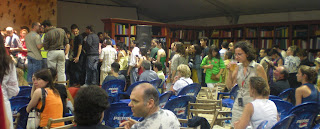 For half an hour the poets signed books, and people in line were excited and had big smiles on their faces. Unfortunately, when the poets tired and decided to head to the hotel, people still in line got a little crazy and started pushing. Security intervened to protect the poets, who at the moment were much like rock stars. I don’t blame anyone; getting their autographs is special.
For half an hour the poets signed books, and people in line were excited and had big smiles on their faces. Unfortunately, when the poets tired and decided to head to the hotel, people still in line got a little crazy and started pushing. Security intervened to protect the poets, who at the moment were much like rock stars. I don’t blame anyone; getting their autographs is special. After the poets left, there was a strong energy in the air. It was like one of those moments you don’t believe just happened and you know they will never happen again--truly an unforgettable night for the people and visitors of Gijón.
I love La Semana Negra!
Besos desde Gijón,
Thania Muñoz
Blog: La Bloga (Login to Add to MyJacketFlap)
JacketFlap tags: horror, 2008, Semana Negra, Paco Taibo, Gijón, Thania Muñoz, crime fiction, España, tertulias, Juan Ramón Biedma, Rafael Marín, Roberto Ampuero, Elia Barceló, Add a tag

Exclusive reports from Crime Fiction's international big-bash by our roving reporter.
I've been looking for a word to correctly translate “tertulias.” Since unfortunately I didn’t bring my big and thick Oxford dictionary with me, I relied on wordreference.com. The definition it gives doesn’t transmit the same meaning to me, but then again, I think about all the translations in the world, from the classics of literature to Latin American literature translated into English, and I convince myself and say "don’t be so stupid, translations are not that bad."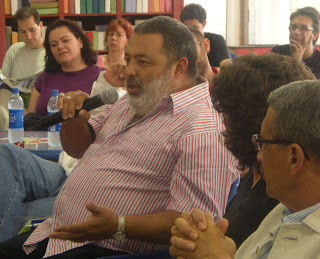
So, according to my online translator tertulias are: literary gatherings, and I’m sticking to that term. At La Semana Negra, every day at five, there are tertulias where the invited writers discuss a topic. It’s an hour-long debate where they give their own opinions and even get into arguments with the other writers.
The first three literary gatherings where dedicated to the “monsters” of literature or film. The panel included Mexican writer, Miguel Cane, Spanish writers, Elia Barceló, Cristina Macía, Rafael Marín, Daniel Mares, Marc R. Soto, Victor Condé, Federico Fernández Giordano, Rodolfo Martínez, Juan Miguel Aguilera, Eduardo Angulo and Manuel Nonídez.
Right off the bat, the debate heated up. Some said Mr. Hyde is the worst monster of all time; others thought it was zombies and of course the always scary vampires. Although the list of monsters was very long, Mr. Hyde took the prize. Rafael Marín took the discussion to another level by saying Mr. Hyde scares us because he demonstrates that “we could be monsters, too.”
After that “Alien” made an appearance in the discussion and writer Elia Barceló defended him, affirming that “the only thing Alien is trying to do is defend himself.” Some agreed, some didn’t, but what made the literary gatherings more interesting was the great number of people listening to this conversation full of some very nerdy details on movies and books.
Although at the beginning in the “Carpa del encuentro”, Semana Negra's main tent, there weren’t many people, as time went by more slowly started coming. I would look around at the puzzled faces: some were ready to get up and say something, and others nodded when they agreed with what one of the writers said.
The guys next to me confided in me (I think because I was taking notes the whole time), “Yeah, I know it’s so cool to find out that you are not the only one that talks endlessly about these things.” These tertulias bring people closer to the writers so they have the opportunity to get to know them in a more personal way. After the debates are over, you see spectators coming up to the writers, saying they agreed with what they were saying, that the other writers were wrong, or something of the sort.
After the “monsters” tertulias, the next two followed the theme entitled “El mal y sus protagonistas” (wordreference.com again: “Evil and its main characters"). This time it was Paco Ignacio Taibo, II, the Cuban Lorenzo Lunar, Colombians Mario Mendoza and Nahum Montt, Mexican writer Eduardo Monteverde, the Chilean Roberto Ampuero, the Chicano Rolando Hinojosa, and Spaniards Ángel Tomás González, Kama Gutier, Juan Ramón Biedma and Achy Obejas. 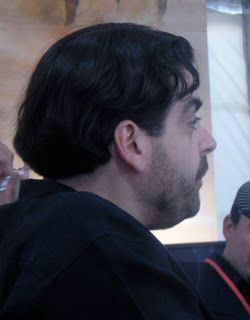
This tertulia focused on evil in these writers' own literature, why they write detective fiction, hardboiled, gothic and such, summarizing why their characters or stories are in some way evil. Juan Ramón Biedma at one point, firmly and passionately said, “Because good characters are boring.”
Simple and clear as that, but Roberto Ampuero, the Chilean writer who teaches at the University of Iowa, said “I live in a country (USA) that is constantly trying to separate good from evil, and of course George W. Bush is always saying that we are good, but it’s a lie and it makes no sense. 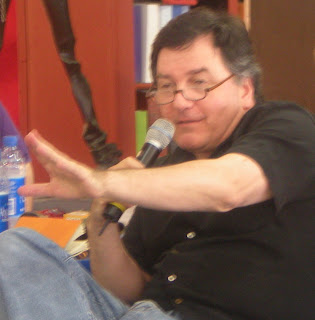 That’s something that intrigues me--why people are always trying to differentiate good from evil, if in reality we are both.” The debate continued on that note, and most of the writers agreed evil is very ambiguous and that we all have the possibility of being the hero or villain, because evil is something within us, something natural.
That’s something that intrigues me--why people are always trying to differentiate good from evil, if in reality we are both.” The debate continued on that note, and most of the writers agreed evil is very ambiguous and that we all have the possibility of being the hero or villain, because evil is something within us, something natural.
I don’t want to scare anybody--I know Vampires and Mr. Hyde are not the prettiest things--but I definitely wanted La Bloga readers to know what topics are discussed at La Semana Negra and to make sure everyone gets a feel of the types of discussion that happen here. But not only that; I also wanted to pass on the excitement and happiness that people who attend this gathering feel.
I’m sure some of you reading this will love hearing your favorite writer talk about his horror characters or why they write the way they do and how they build their characters. It’s a special thing and the spectators certainly recognize this, because during the discussions, they didn’t stop taking photos and notes. As someone behind me said, “I’m posting this on my blog.”
Saludos desde Gijón!
Thania Muñoz
Blog: La Bloga (Login to Add to MyJacketFlap)
JacketFlap tags: Semana Negra, Paco Taibo, Gijón, Thania Muñoz, crime fiction, España, Germán Robles, Jesús Palacios, Fernando Mendéz, El Vampiro, A mordiscos, cine de oro mexicano, Christopher Lee, 2008, Add a tag

Exclusive reports from Crime Fiction's international big-bash by our roving reporter.
4th day - Mexican actor Germán Robles 
This year La Semana Negra is paying homage to Germán Robles. Robles is a very well known actor in México and other parts of the world for the collection of vampire movies he did during the late 1950s. He is considered “the” Latin vampire of our time. As critic Jesús Palacios (author of the ¡A mordiscos! book distributed free each night) said, “the Americans have Bela Lugosi, the English, Christopher Lee. We have Germán Robles, one of the greatest”.
La Semana Negra has been screening his movies since Saturday, every night at ten thirty. Since the first day the tent has been full, definitely because at the beginning of each screening, Germán Robles himself presents the movie, and tells spectators an anecdote about the movie. Although he is an elderly person now, he still maintains a posture and an enviable elegance. He is a great actor and is not afraid to say it himself, as on Sunday, “I’m a great actor, and since I don’t have my grandma to be saying good things about me, I have to say it myself: I’m a really good actor!” 
Although he has been recognized for his work around the world, and his movies have been translated into more then fifty languages, he is not very well known in Spain. This is especially sad, because although his whole career is centered in México, Robles is from Gijón.
This was a big surprise for the people of this city. Robles’s dad fled the country during the years of the war and settled in Mexico City. Seven years later his wife and son Germán followed him, and the seventeen-year-old Germán Robles started working as an actor and draftsman. He filmed “El Vampiro” in 1957, directed by Fernando Mendéz, before Christopher Lee!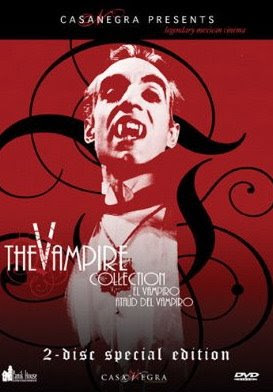
Germán told Sunday’s audience an amazing anecdote about this. He said he had a Mexican friend who used to work at London’s BBC, and at an event he had the opportunity to talk to Christopher Lee. Lee asked him if he was from México and if he knew the actor Germán Robles, to which the reporter, Robles’ friend, answered, “Yes, yes, we are like brothers”. Then Lee told him, “Well, tell Mr. Robles that he was been a true inspiration for me.” Who would have thought that a Mexican inspired the acting as a vampire of an Englishman! An incredible anecdote that Robles told with great pride and a definitely well deserved recognition.
I don’t know how hard it is to find his movies now, but it is definitely worth a try. There are incredibly good Mexican movies from the so-called, “cine de oro mexicano.” Instead of gothic cathedrals or houses with enormous chandeliers as we are used to seeing in dark vampire movies, you see an old Mexican hacienda in a little town of provincial México, a beautiful actress, and an indigenous man, endlessly praying throughout the movie.
Germán Robles's character is an elegant vampire who speaks well, and as Robles himself said, “you can smell his lavender cologne from meters away.” Well directed and aesthetically perfect, even though it was 1957, the special effects are good and the acting amazing. 
I emphatically recommend Roble’s vampire collection, and as La Semana Negra continues, so the screenings will continue special homage to a special bloodsucking Gijones.
Thania Muñoz
Blog: La Bloga (Login to Add to MyJacketFlap)
JacketFlap tags: Semana Negra, Paco Taibo, Gijón, Thania Muñoz, crime fiction, España, churros, Poniente Beach, 2008, Add a tag


Exclusive reports from Crime Fiction's international big-bash by our roving reporter.
3rd day - Sunday, June 13
I would like to dedicate this post to the tents of La Semana Negra, to the smell of oily churros, waffles, French fries and sandwiches that populate the air.
I’d heard that at La Semana Negra there was more than books, writers and conferences, but to see it with my own eyes, is an incredible experience. There are tents full of horror books, next to a sandwich and hamburgers joint. Needless to say, a churro tent is located between a detective fiction book tent and another one of fantasy genre.
The event this year is held at Poniente Beach in four tents where most of the film screenings, conferences and other events take place. Your shoes get full of sand everywhere you go, but if it rains, as it did last Friday, what you step in is mud. Nothing to complain about though; you’ll still enjoy a great conference about new book releases or a screening of the 1950’s classic vampire movies of “El Vampiro Mexicano” with an introduction by the vampire himself, the great Mexican actor, Germán Robles. [more on that tomorrow]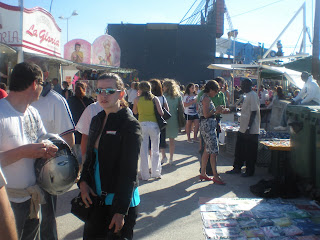
The fair is set up as a long line of tents facing the sea. It starts everyday at five o’clock and in a few hours all the tents are lighted. Tons people walk around, eating, talking, and sporting La Semana Negra hats--a black, detective hat given free as a pretty keepsake to people who attend.
There are also tents set up as bars, nightclubs and restaurants. At night, these places are full of people listening either to a live rock band or dancing to the sounds of techno or house. Paco Ignacio Taibo, II proudly said that this year “there are as many bars as bookstores.” When he said this, you could see his gray-haired mustache became a big smile.
La Semana Negra also contains a big concert stage where everyday at 10:30 there are concerts, and spectators comfortably sit on the sand, drink beer, sidra, or their drink of choice and enjoy the music.
The tent bookstores close at 12pm, so it is not rare to see people with bags full of books, tired of carrying them around, having a beer while reading a book they just purchased. I shed a tear every time I see someone with a book by Dashiell Hammett in one hand and chocolate churro on the other. Plain and simple paradise. 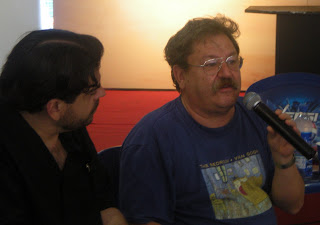
This picturesque scenery and the great variety of tents is something Paco Ignacio Taibo II tries to convey every year. In the inauguration ceremony he made a note of that (roughly translated): “this is a celebration for the masses, for the great majority”. And this is entirely true.
You don’t only see intellectuals, professors and other nerds walking around the fair. There are all sorts of people--from the abuelito who can barely read anymore because his sight is not as good as before, to the young guy who prefers to wait until the movie comes out instead of reading the book--who come to La Semana Negra just to have a good time and maybe, after looking at so many books, even buy one.
Great books, food, drinks, and people, just some of the many things this event brings to the city of Gijón and to the people who come and visit during this amazing week.
Besos desde Gijón!
Thania Muñoz
Blog: La Bloga (Login to Add to MyJacketFlap)
JacketFlap tags: Semana Negra, Paco Taibo, Gijón, Thania Muñoz, España, 2008, Add a tag

1st day Friday the 11th
On Friday, I took the famous Black Train to Gijón. I still get the chills when I pronounce these words, although the train is not black (as I had excitedly imagined), the people who get on it definitely are. Not because of their skin hues, of course, but because the train is full of people who write detective fiction, thrillers, horror, fantasy, comics, testimonial, historical, and science fiction books and the rest of us who love these genres.
The writers, visitors, and the press (which I’m part of) met at Hotel Chamartín, which is located in the middle of the train station in Madrid. It was a big group of people from all over the world, with luggage, cameras and smiling faces. My first concern was the organization, how would they keep us together. It seemed as if everyone was in their own little world, but soon I discovered their formula.
Most people participating in La Semana Negra, have attended the event more than once. The famous Chicano writer Rolando Hinojosa told me, “like me, out of the twenty-one years of la Semana Negra, I’ve only missed one, back in 2005”. Everyone knows each other; if one gets lost, someone will notice and look for you. The second way of keeping everyone together is by walking as a group; yes, I felt I was back in middle school and taking a field trip to the museum.
Paco Ignacio Taibo II, la Semana Negra’s founder and continuous organizer, is the leader of our group. With his emblematic cigarette on hand, he lead the group to the train and another member of the organization made sure no one was left behind. What seemed as an impossible task was handled by old-fashioned comradeship.
Before we got on the train, the first issue of A Quemarropa was distributed. This newspaper details the agenda of day, news of invited writers, conferences, concerts and other events at Gijón. The paper is released every morning of la Semana Negra. After we took a look at the newspaper, a group picture was taken and we finally got on the train. My adventure was starting.
As soon as the train left the Madrid train station, writers and reporters alike started walking the aisles, talking and telling each other jokes, laughing and overall having a good time. That’s the other outstanding thing that I would like to highlight about the people who attend this event. Although the genres paid tribute at la Semana might be considered too “black” for every member of the family, it’s still a family event.
Imagine a crime friction writer, a comic writer, and a fantasy writer having a deep conversation about their latest works, while the Cuban writer Amir Valle’s son is pulling down his pants, and the Spanish comic writer Juan Diaz is trying to put his baby to sleep, with no success, to say the least. Not the typical picture of writers smoking cigars and drinking Mojitos in the middle of a smoke cloud, but there is still great conversation, respect for each other, and love. Truly a family event.
We left the station at 8:00am and arrived at Gijón at 6:00pm, a long ride, which included a press conference: Chilean writer Roberto Ampuero talked about his latest book, El Caso Neruda; Colombian writer Mario Mendoza about his book Sátanas. And many others, a long list of new titles and writers that I would share through email.
There was also a concert by Yampi, a Spanish artist, and a funny, but short talk with American writer George RR Martin. At around 4:00 we stopped at the little town of Miéres, where a typical Asturian (northern Spain) band led us into the town to a place where Asturian sidra and appetizers were quickly consumed by us all.
In Gijón, after a short stop at the hotel, all of us headed to playa Poniente, where la Semana Negra tents are set-up. There were already a great number of people looking through tents full of books, sweet desserts or clothing--a weird mixture of items, but this is what makes la Semana Negra a warm, popular event: it's dedicated to literature and to the people who love it.
The inauguration black ribbon was cut by Gijón’s mayor Paz Fernández Felgueroso and Paco Ignacio: la Semana Negra was officially inaugurated!
Great first busy day of a long awaited event. Looking forward to the rest of la Semana Negra. Hope everyone enjoys the post.
Saludos desde Gijón!
Thania Muñoz
Next post:
Rolando Hinojosa talks about his 10-year experience in la Semana Negra.



¡Ajua! Tania. Thank you for your reports on such a wondrous celebration. Did you get the material you sought on the Mexican writer, after all, your raison d'etre for Semana Negra-ing? And, I hope you're subsisting on more than beans and tortillas.
ate,
mvs
Thania - congratulations again on a wonderful job reporting about the surreal and amazing experience that is Semana Negra. Although nothing can replace being in Gijón, your dispatches recreated much of the color, excitement, and life of the event. You enriched my drab days, for sure. Gracias,
Manuel
Thania,
We'll always remember your contributions to La Bloga and your refreshing reports about La Semana Negra.
Thanks for taking the time to share your thoughts and feelings with readers.
RudyG
¡Gran trabajo, Thania! Has captado de maravilla el espíritu de la Semana Negra. Ahora que por fin he dormido una semana entera, he leído todos tus posts seguidos, y ha sido como si hubiera estado allí... Bueno, sí que estuve allí. ¡Ha sido como si estuviera allí SIN TRABAJAR! :D Siempre, siempre serás bienvenida. Gijón y la Semana Negra son tu casa.
Cristina Macía
Thania -- it's been a joy to read your posts...I feel like I've taken the trip as well. Thanks so much for your sparkling, detailed coverage and for gracing La Bloga with your guesting!
LA
Great job Tania,
He aprendido sobre la Semana Negra en España.
saludos,
René Colato Laínez
¡Gracias a todos!
It has been a pleasure being La Bloga’s reporter/guest blogista! I’m so happy that people have enjoyed my posts and thank you for all the kind comments. It’s been a great learning experience, literary and budgeting wise, so don’t worry I’m subsisting on more than beans and tortillas! Reading today’s comments I saw the name Cristina Macía; She is in charge of la Semana Negra’s organization team in Gijón, I’m so glad that she enjoy the posts also (I’m happily screaming right now!!)
The last thing I would like to say is,
I Love La Bloga!
And we love you, Thania!
Gracias, querida Thania por la hermosa foto que me has enviado al email personal y que ahora veo en la bloga, gracias por las lindas palabras que dices sobre nosotros y gracias, especialmente, por tu excelente reporte sobre esa hermosa locura que sigue siendo la Semana Negra.
Un beso mío y de toda mi familia
Amir, Berta, Tony y Lior
Gracias, Thania, for these wonderful reports re Semana Negra. I hoped to make it this year, but...y me duele no haberlo hecho. After reading your posts, I know I have to make it to Semana Negra next year. Lucha